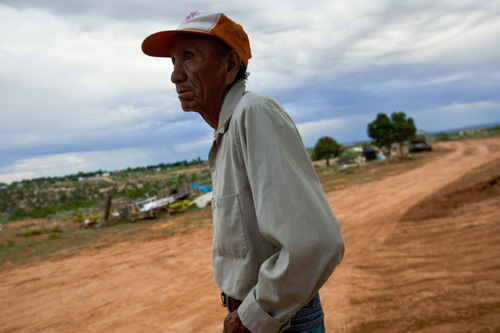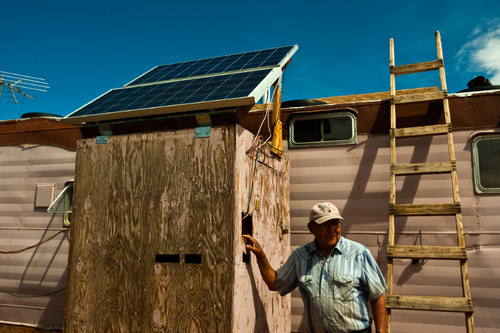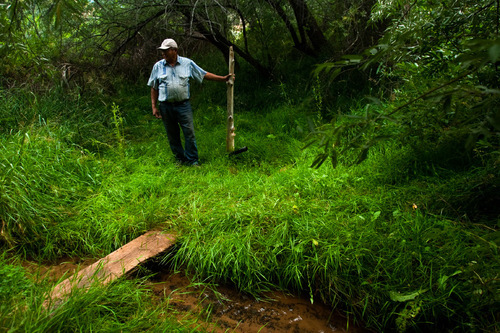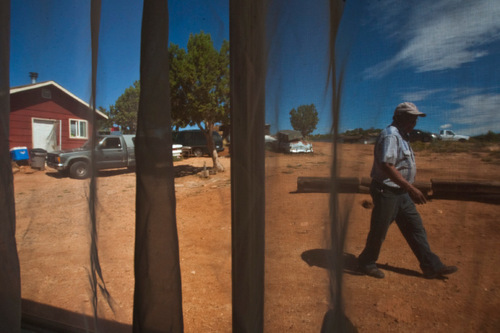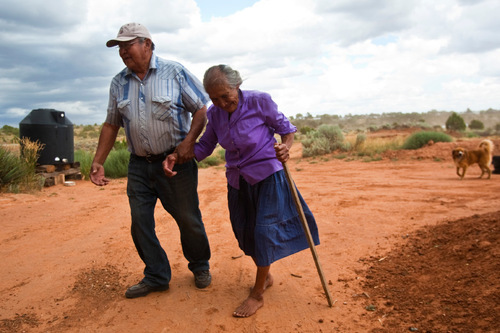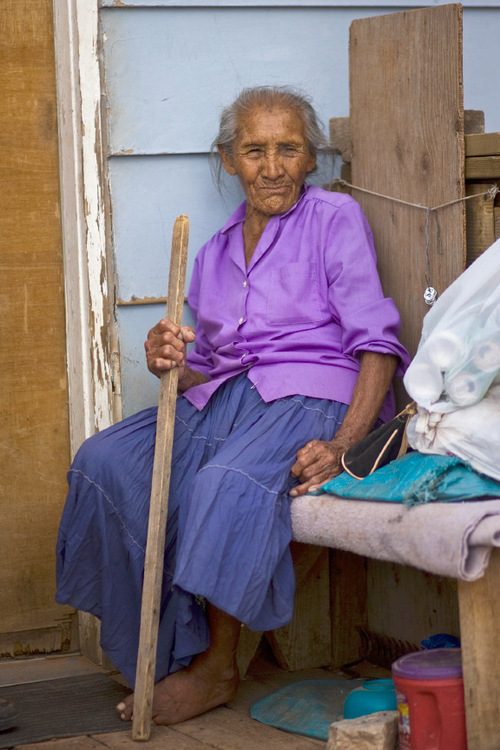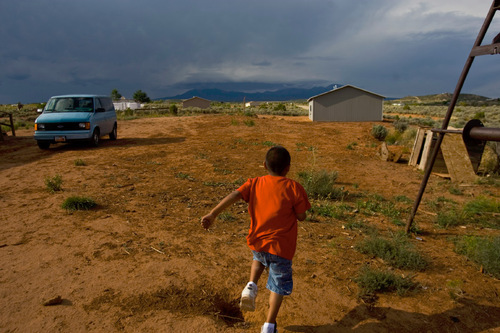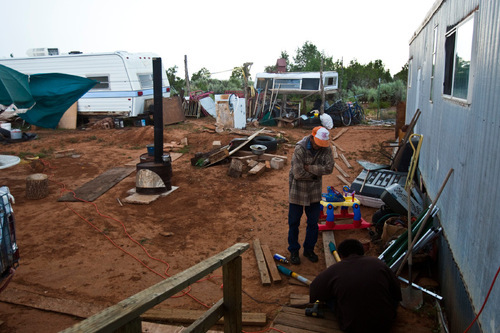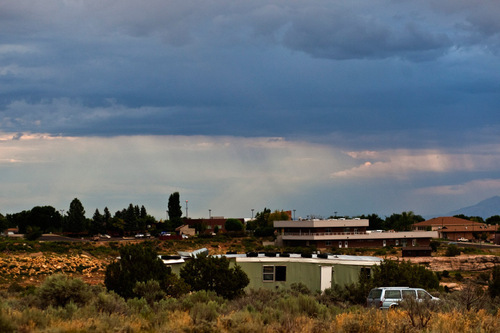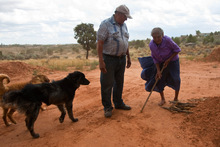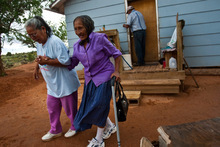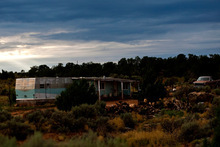This is an archived article that was published on sltrib.com in 2010, and information in the article may be outdated. It is provided only for personal research purposes and may not be reprinted.
Westwater • When the Lord spoke to Harry Hutchins on this sacred ground of patched-up trailers and outhouses, he told the aging Navajo to stay in Westwater and pray like his ancestors. So after honoring the sky and Mother Earth, the 74-year-old relies on car batteries to illuminate his light bulbs, hauls water inside for cooking and bathes himself on summer days in the stream at the bottom of the canyon.
Tree branches arch over lush grass at that spring, once the only source of water for all those who lived in the Blanding area 100 or so years ago. On the other side of the canyon wall, the years brought modern magic to the pioneer city, as water flowed from taps, toilets flushed and electric lights glowed.
About half a mile away, the Navajos of Westwater are still waiting. In what is perhaps Utah's longest, most complex battle over utilities and urbanization, accusations and blame flow freely. People have debated a solution for decades.
So 65 years after Hutchins' father brought his family to the region to work for white pioneer families, herding sheep, cutting wood and farming, his elderly son continues to live cloistered from civilization — playing cards by a dim kerosene lamp as the city flips on its lights.
—
The long wait •. Westwater is hardly a secret. Stand near an ancient pueblo on the grounds of the local museum, and the tops of trailers and aging cars can be seen poking up from the other side of the canyon. The museum's exhibit on Westwater and American Indian history has made visitors weep, as they recognize their own family members in the faded photos.
To receive water and utilities, the area needs to be annexed and developed to city standards such as paved roads and fire hydrants. The few dozen residents would have to follow city health and safety codes, from having their garbage collected to putting their dogs on leashes.
It would be a radical transformation of this parched, red-clay land ,where Indians have lived for generations, though the Navajo Nation only purchased it in 1986.
Drive down the road that slices the small community, and roaming dogs emerge from clusters of sagebrush amid scattered homes, some abandoned.
Nothing is simple about this tale. Some people fault the selfishness of city politicians for delaying utility improvements. Others say the changing whims of the Navajos stalled progress. Though everyone seems to want water, some residents fear too much involvement by the city would mean losing independence and giving up traditional ways. And becoming dependent also means the potential for burdensome bills.
Albert Cly, 71, moved back to Westwater, his childhood home, from Salt Lake City about six years ago. He and his wife, Gladys, purchase city water and have it trucked to the tank near their home for cooking, bathing and drinking.
"We ask them for water, they won't let us have a drop," he said, standing by the cool of the Westwater spring.
A recent front-page article in The Blue Mountain Panorama announced the opening of the $2 million Blanding water-treatment plant, infuriating the couple, who rely on a solar shower.
When Cly decided to return, he was drawn by the peacefulness, the mountains and endless stars. A recent meteor shower became a nightly show, where residents could see four planets simultaneously and watch the space shuttle glide by.
Gladys would prefer to go back to Salt Lake City, with its easy access to stores and pancake- and steakhouses. But they live better than some, relying on a solar panel to power their lights, TV, toaster and refrigerator.
—
Progress • When construction began earlier this year on eight homes being donated to the community, Cly stood on a hill, overcome with joy for his neighbors. At $50,000 each, the homes will be given to some of the oldest and youngest residents this month, thanks to Hearts and Hands in Action, a nonprofit group which headed up the project.
Anderson Chee, 32, Cly's nephew, and his wife sorted through piles of clothing, as they prepared to move on a recent Thursday morning. After living with his wife and three children in a one-room house with a dirt floor, Chee knows his new house will be better insulated against winter temperatures and snow. They'll have an indoor shower, a luxury he never had while growing up.
Still, maintaining his people's values is paramount to Chee.
"I really don't want help from the city," he said.
Solar panels will provide electricity. Water will flow from the taps, a first for some, but will still be hauled in.
"What we're doing with the water is stopgap, at best," said Andy Hindes, Hearts and Hands' co-founder. "You can't go years and years with just filling a water tank on the side of your house."
He says city officials initially fought the project, calling the future homes "shacks" and "shanties," a criticism the Santaquin-based nonprofit disputes. More than 80 volunteers, primarily from outside the Blanding area, built the homes over five months.
"Mostly people [in Blanding] were saying, 'Why are you building homes for the Indians? They're just going to ruin them,'" Hindes said. "I can show you some homes in Blanding that look a lot worse."
City Manager Chris Webb said the city simply wanted them built to code.
"What we did say is, 'We don't want to create a slum area," he said, noting that proper plumbing and electrical work will ensure people's safety.
Most of the funding — more than $300,000 — came from the Navajo Nation. The federal Bureau of Reclamation paid for the water tanks and systems. If the tribe provides additional funding, four more houses are expected to be built for the remaining permanent residents.
Perhaps the oldest benefactor is Jesse Herderboy, who couldn't remember her age on a recent wind-whipped afternoon, as she collected wood for her stove. The elderly woman moved to Westwater when there were few houses in Blanding.
"To have her be able to go to the bathroom inside in winter ... is inconceivable," Hindes said.
—
A different world • On the other side of the canyon, in tidy homes sprinkled with pink petunias and red rosebushes, dishwashers hum and air conditioners cool. At Christmas, carolers have crossed the canyon to sing and donate food to the residents, whose children attend school in town. A few city residents share the bounty from their gardens, troubled by the inequities between the two communities.
"I think it's a disgrace," said Madalyn Bills, a clerk at the Edge of the Cedars State Park Museum, who moved to Blanding in 1969, when Westwater was dotted with traditional hogan homes constructed of earth and timber.
But Mayor Toni Turk says it's up to the Navajo Nation, the landowners, to take the next step.
"The way the city looks at it, it's a subdivision," he said.
The improvements needed for annexation could cost more than $4 million, according to Bureau of Reclamation estimates, a cost that Teresa Showa, a hydrologist, doesn't see as necessary.
"These guys are just so good at putting hurdles," said Showa, who doesn't live in Westwater but works for the Navajo Nation's Department of Water Resources. Rather than make all the changes, a water pipe on the county road would be a faster and less-expensive solution — and Indian Health Services would help pay for it, she said.
"These people played football together [in high school]," Showa said. "They were on the same team. ... You would think they would want to help each other out."
But the law would have to change for the area to receive city services without annexation. In the meantime, the city says it's trying to treat everyone equally.
"We're talking hundreds of thousands of dollars we can't place on the backs of our citizens," said Webb, the city manager. "That's why it's never happened. … Natural market development happens when it makes sense."
—
A better life • Some Westwater residents aren't convinced city water will flow across the canyon anytime soon. But progress has been made — mapping and planning for future improvements and, of course, the clean new houses. Decades after his father's arrival, Hutchins will soon leave his trailer and move into one of the new three-bedroom homes.
Three generations will sleep under the same roof, as his son, Harrison, and his 16-year-old grandson join him. In August, Harrison and his son repaired a truck trailer as rain began to fall. Sheep skittered down the dry red road as it absorbed the water, turning it slick and smooth.
Navajos helped build Blanding's first structures in its early days. If they had water now, they could grow their own food and plant trees, Harrison said. A new life at Westwater could begin.
"It'll change our lives totally," he said.


